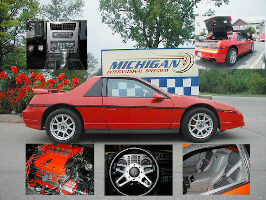I guess I will use this thread as the "information" thread about the 3800NA flywheel vs the 3800SC flywheel. If you remember this subject came up in another thread which has the 3800 FAQ posted I have been working on for some time.
The first thing I notice about people that are suppose to be in the " KNOW " about helping others with correct information.... they should be posting and telling some numbers to indicate they have actually pursued the investigation of said information. Just to show some pictures and say… ‘balance the flywheel because this picture shows a smaller weight’ is useless information. We don’t know how the 3800NA flywheel really is without measuring and understanding the true imbalance built into it.
Lets think about it. If someone is going to tell you the thickness of cutting the flywheel, we expect a measurement in thousands of a inch. We see .840 thrown around all the time. Personally, if you just measure the stock 2.8 flywheel and see that the measurement is taken from the crank flange to the disc surface, this is what we are going to be looking for on the 3800 flywheel so the disc and pressure plate are in the correct location for the slave to do its work releasing the clutch and fully engaging the clutch. I have found .860 gives a better feel to the petal on the 88's. Its only .020 difference here... but when the slave is throwing 1.1 inches, thousandths makes a big difference.
Now about this balancing... I finally went to a machine shop that specializes in balancing flexplates and flywheels for NASCAR type engines. I had them show me exactly what the machine looked like and how it all functioned.
This is where no one else has bothered to provide the information so everyone can be a little more educated in this subject.
The STOCK 3800 SC flexplate will imbalance at 217 grams to 212 grams in 3 flexplates I had with me...
The CUT down version 3800 NA flywheel will imbalance at 194 grams. I only had one cut flywheel with me at the time.
So, what is the percent of 'safe' .... ? Bear racing indicates that there is a 10% tolerance in OEM casting measurements.
So, 10% of 215 grams is 21.5 grams... So, we can be +21.5 or – 21.5 grams if our baseline is 215 from the stock flexplate. Now, I am pretty sure that the 3800NA flywheel is always going to be short on grams, and not ever plus.. We have already seen that NA flexplates have a smaller amount of weight material than the 3800SC flexplates. It is difficult however to know what is going on with the 3800NA flywheel because the weight is cast into the flywheel and extends around the flywheel different than the flexplates.
So, if the CUT flywheel I had at the machine shop was 194 grams, it was within 10%... HOWEVER, Bear Racing indicates that you will feel 20 grams of imbalance if it is wrong.
Now we take 215 – 21.5 and we have 193.5... Oops.... Now we have a 3800NA flywheel that imbalanced 194... This flywheel is off enough that it can be felt with poly mounts at idle for sure. Is it going to knock a bearing out? Bear racing indicates that it is within GM tolerances.
So, I guess I can say that I am very lucky that I have installed about 10 manual applications with no idle vibration to speak of. Now that I know the location of the imbalance needed to be counter drilled, I can do it myself to the tune of about 20 grams. I plan to try this on another flywheel in about 2 weeks to see if my calculations are correct to getting close to the magic 215 grams imbalance.
It cost $100 for imbalance work at Bear machine per unit. I dropped $500 there so you guys had this information.
Loyde
[This message has been edited by FastFieros (edited 03-19-2006).]





















